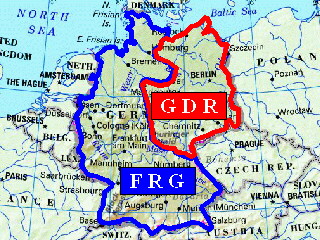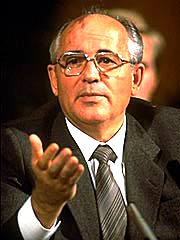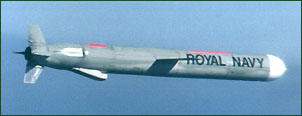German
Reunification and the Present
Table O' Contents
The
Reunification of Germany
Helmut
Kohl - Chancellor (1982-1998)
Current
Issues in Germany (Early 1999)
- Back
to the main page
The Reunification of Germany
The fall of the German Democratic Government (the East
German government) was considered quick and unexpected by many. It
was triggered by the decaying of other Communist regimes throughout East
Europe and the Soviet Union at the end of the Cold War. By 1988,
Gorbachev was enacting "liberalizing reforms" in the Soviet Union, which
went against East German goals.1 These new Soviet publications,
that were viewed by the East German government as "dangerously subversive",
were forbidden.
Along with the fall of other Soviet regimes, several
other factors brought about the fall of the East German government.
Not only were the people becoming less and less content with the government,
but by the summer of 1989 the reforming Hungarian government began to allow
East Germans to escape through Hungary's Austrian border. Once this
began, the Berlin wall became useless for keeping the people within East
Germany. Thousands of East Germans fled the country this way, while
still some others south asylum in West German embassies in the east.
By this time, mass demonstrations defying East German authorities had broken
out in East German cities. The people demanded reform, and they were
backed by mass numbers of citizens.
The SED struggled to stop the flow of refugees to
West Germany and the embarrassment that it caused. On November 9th,
1989, the East German government announced new travel regulations, which
were intended to enable those who wanted to travel to the West to do so
directly from East Germany and only with official permission.
This announcement, however, was widely misinterpreted as a decision to
open the Berlin Wall. Soon, massive crowds demanded to be let through,
and unprepared guards were forced to let them. All through the night
of November 9th, tens of thousands of East Germans poured through the crossing
points in the the wall and happily reunited with the West Germans.
In the process, the wall was literally torn to pieces.
The fall of the Berlin Wall proved to be the end
of the German Democratic Republic. Soon, even larger public demonstrations
than before demanded a people's voice in the government. Since East
Germany was rapidly losing its population and therefore about everything
else, the government had no choice but to allow free, multiparty elections.
An election was soon held, and the old SED (then recently renamed the Party
of Democratic Socialism) lost in a big way, while Helmut Kohl's Christian
Democratic Union, already leading the west, became the largest political
party in East Germany.
The People's Chamber was, for the first time, democratically
elected, and negotiations for a treaty of unification began right away,
since the people were leaving East Germany quickly. In July of 1990
the German monetary system was united, and the Deutschmark spread to both
Germanys. Helmut Kohl convinced Gorbachev not to object to a unified
Germany joining NATO in return for German financial aid to the Soviets.
In September of 1990, the unification treaty was ratified by the Bundesrat
and the People's Chamber. On October 3rd, 1990, the treaty went into
effect, and West and East Germany merged to again form one united Germany.
Hooray!
Helmut Kohl - Chancellor (1982-1998)
Helmut Kohl was chancellor of West Germany until Reunification,
when he became chancellor of reunified Germany. He was perhaps Germany's
most successful chancellor, unifying Germany and reigning almost as long
as Otto von Bismarck. Though initially domestic policy was his strong
suit, he went on to integrate Germany into Europe.
Kohl's thick Rhineland accent and rather poor speech
delivery led people to believe he lacked intelligence, but in actuality
he was an expert political operator.2 Kohl came to power
during a time of difficulty for Germany. Germany was split in two
and suffered from mass unemployment. Kohl and his coalition government
consisting of the liberal Free Democrats, the Christian Democrats, and
the more conservative Christian Social Union, managed to get past these
and other problems. Helmut did not make bold initiatives very often;
many described his policy as "Aussitzen" (sitting out), meaning he sat
and waited until the problems went away or his opponents gave in.
This "Aussitzen" view only lasted until Reunification,
when Kohl took the initiative and, through a mixture of pressure and persuasion,
convinced the leaders in the East and West to accept a unified Germany,
ending the Cold War division.3 Not long after Reunification,
Kohl began to make sure that Germany was integrated into Europe, in order
to avoid further rivalries between powers. In 1995, Germany joined
NATO.
In 1990, Kohl had promised that within four years,
East Germany's economy would be significantly recovered. However,
the eastern recovery was much slower and more difficult than planned.
Billions of Deutschmarks were spent, but unemployment remained at around
18%. Furthermore, the German government was bankrupting itself trying
to rebuild East Germany. Despite their best efforts, the East German
economy was still showing no signs of recovery. In 1997, East
Germany was still only producing 3% of Germany's entire exports while also
building up a billion dollar deficit. Once the economic boom of the
post reunification years slowed down, and after the disappointment in the
East came around, Kohl began to lose his popularity. Even later on,
some Germans were not happy with the European Monetary Union that Kohl
so fervently supported. All this came back to haunt Kohl in the 1998
elections against Gerhard Schröder. The German people were becoming
angry that after sixteen years of being under Kohl, the economy had still
not recovered. Therefore, when a candidate came along who proposed
change, the German people were quick to throw in their support.
Current Issues in Germany (Early 1999)
Currently, Germany is facing post reunification economic
problems caused by a number of factors including the flow of refugees into
Germany, the flow of East Germans leaving to West Germany, and the poor
economic conditions left in East Germany by the Communists. In the
East, the unemployment rate remains at about 18%, despite efforts to lower
it. To add to that, Germany has extremely loose immigration and refugee
accommodation laws, which is allowing for an influx (in 1996, anyway) of
about 300,000 refugees from former Yugoslavia, and about 100,000 Kurdish
refugees.4 This is more refugees than accepted by all
other European countries combined. The refugee problem not only caused
the unemployment rate to rise, but also caused huge housing shortages throughout
Germany and especially Berlin.
Germany has been a large supporter of the actions
against the Serbs in Kosovo. For the first time since the World Wars,
German airplanes are in action. Many of the NATO air bases are situated
in South Germany, where it is only a short flight into the Balkans.
Even though Germany is in full support of the air strikes, there must be
at least some worry about the possible outbreak of a larger war involving
Russia. While America is relatively safe, being on the other side
of the world, Germany is probably the first place the Russians would go
if they were to attack. Its large amount of NATO air bases and also
its proximity to both the Balkans and Russia would make Germany the prime
target for an initial assault. That is not the only problem.If
a Russian leader were to decide to try to assume the leadership in Russia
by starting a war with NATO, not only would this new leader quickly
gain support from Russian nationalists, but also from the entire Serbian
population in the Balkans. These actions would lead to an all out
war in which Germany would (potentially) be the first victim.
1. "Germany, History of".
2. "Kohl steps into the history books".
3. "Kohl steps into the history books".
4. "Year in Review 1996: World Affairs".
(Back to top)


